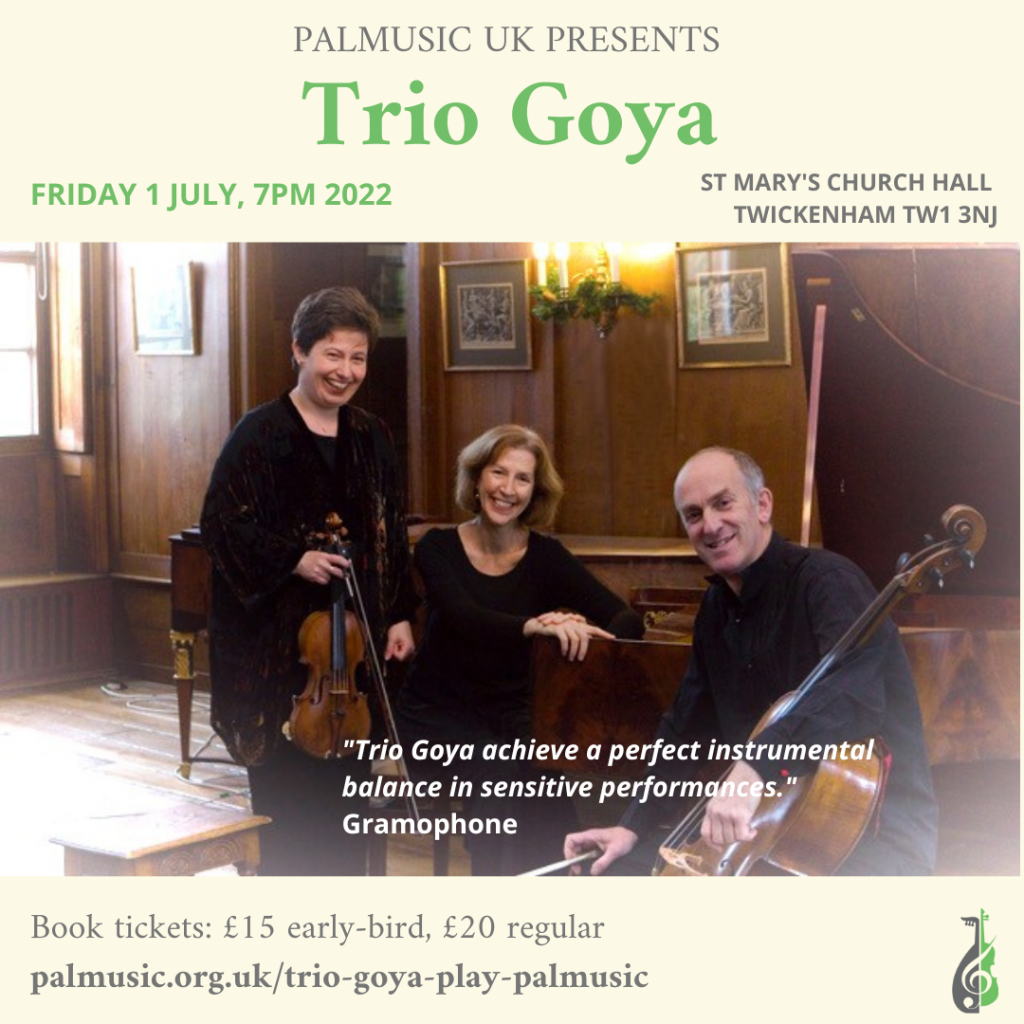With Trio Goya’s upcoming concert in Twickenham on Friday 1 July for PalMusic UK, we asked Maggie to write about what brought Trio Goya together and what inspires their work. To buy tickets and find out more about the concert visit our page.
Maggie writes:
When I look back at the formation of Trio Goya, I can see that it was a direct outcome of my growing fascination with the fortepiano (the term we now use to encompass all forms of ‘early’ piano) and a desire to explore chamber music that had the fortepiano as a central feature. Having spent many years immersed in the Baroque period as a harpsichordist, it was somehow a natural progression to start uncovering the various worlds of the fortepiano and to team up with players who had also devoted themselves to their earlier versions of violin and cello. I consider myself enormously fortunate to have what is an endlessly interesting collaboration with Kati Debretzeni and Sebastian Comberti. We had all been for many years, participants in the large and rich pool of musicians exploring early instruments and it now feels inevitable that we would come together as a trio. We’re lucky enough to have a shared approach to our repertoire but also many of the other elements that make for a happy chamber group – a shared sense of humour, a desire to stay close to the languages of our composers while bringing ourselves into the equation and of course like most musicians the world over, a love of shared meals!
All three of us are probably most suited to playing live concerts and yet we have had two experiences of recording that stand out. Our recording of Haydn trios “The Heart of Invention, Trio Goya”, was recorded in a studio best known for being much sought after by rock musicians. This was Real World Studios, the creation of Peter Gabriel, in the little village of Box, Wiltshire. Through my friendship with Peter, we were offered one of the smaller rooms at Real World. Our big concern was that it would be dry and totally unsuitable for our instruments and for the kind of listening we like to do which depends so much on a clear but generous acoustic. The opportunity was however too good to ignore and with the incredible skills and commitment of our producer, Nick Parker, we could relax and sink into three days in seclusion, able to record at any hour of day or night that we fancied, housed in comfortable accommodation and fed spectacularly well.

The next recording project was of the Beethoven opus 1 trios and in a very different location, we again found ourselves in a place where we could concentrate without distraction and explore the music without feeling that every nuance had to be planned in advance. Once again we were in idyllic surroundings – Aldeburgh – and this time had the joy of recording in one of the truly most beautiful acoustics, the Britten Pears Auditorium at Snape. Once again, Nick Parker was our astute and generous producer. Once again, we had a support team that included the exquisite tuning of Edmund Pickering. This aspect of playing early pianos is crucial. We often feel that there is a fourth member of the trio , this being the person who so skilfully stays on top of the tuning.
Our programme for PalMusic contains two trios very dear to our hearts. This performance however represents a departure for us as I will be playing a ‘modern’ piano and we will all be at A 440 pitch which is somewhat higher than what we normally play at. We’re delighted to have this chance to see what happens in these trios when we bring our experience and knowledge of early instruments into a slightly different sound world. In between the trios is a group of 3 pieces that take us into a more dreamy and romantic world. The Satie will be well known to many. Surrounding it, we look forward to offering two cello and piano pieces that are perhaps less familiar.
Buy your tickets and find out more about the concert – visit our web page.
